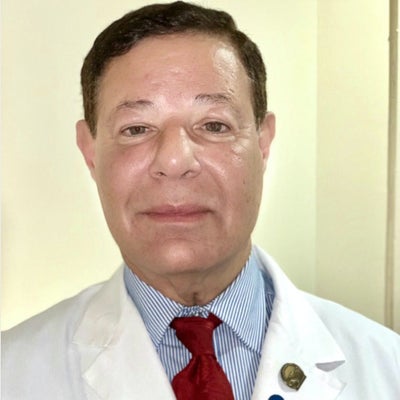Profhilo is a unique injectable hyaluronic acid treatment, designed to boost skin hydration, support, tautness and elasticity. This clear, aqueous substance is a mix of high and low molecular weight, pure hyaluronic acid (HA), without the cross-linking chemicals found in hyaluronic acid-based dermal fillers.
When injected into the face, neck, décolletage, inner arms, thighs, or the backs of the hands, it spreads evenly throughout the skin. Unlike most hyaluronic acid injectables, Profhilo isn’t a dermal filler treatment per se, or even a simple “skin booster”; it’s a type of injectable described as a "bio remodeling" agent, according to Dr. Nelson Lee Novick, a board-certified dermatologic surgeon in New York City and Clinical Professor of Dermatology at Mount Sinai School of Medicine.
“Profhilo works by stimulating collagen and elastin production by fibroblasts in the dermis and keratinocytes in the epidermis, as well as by preserving the health and vitality of the fat cells in the subcutaneous tissue,” Dr. Novick explains. “The result is greater skin support, diminished laxity, and improved suppleness that translates into plumper, more dewy, more youthful skin.”
Although this treatment won’t change face shape or erase deep wrinkles, the benefits of Profhilo injections include a subtle improvement in overall skin quality and fewer fine lines, for smoother, brighter skin.
Profhilo is not yet FDA approved, so it’s not officially available in the U.S., but clinical trials are ongoing. However, it has been widely available in Europe and other parts of the world since 2016.
Until recently, Dr. Novick also had a practice in Israel, where he frequently treated patients with Profhilo. "I have personally been injecting Profhilo routinely in my satellite practice abroad for over six years, treating crinkling, crepiness, and mild laxity of the face, neck, decolletage, abdomen and upper arms and upper thighs.” He says the results have been “very gratifying, especially when combined with other HA fillers."
Pros
- All skin tones and types can benefit from Profhilo treatments.
- It's said to create a “lit-from-within glow,” a luminosity that comes without a long-term commitment to a complicated skin-care regimen.
- Among HA skin-booster treatments, Profhilo has one of the highest concentrations of hyaluronic acid, according to its manufacturer, IBSA.
- Profhilo stimulates the creation of four types of collagen, plus elastin, to firm and smooth the skin, according to a 2016 clinical study (on in vitro cells), funded by the manufacturer.
- The treatment is quick—only about 15 minutes—and has no real downtime, save for some injection-site lumps that typically fade within a day or two.
- It can be performed all over the face and body, including the neck and chest.
Cons
- Profhilo results can be subtle and difficult to see in post-procedure photos, since it simply makes skin look plumper and healthier. Some reviewers on RealSelf who were expecting a greater improvement in skin laxity say it wasn’t worth the money, so it’s important to have realistic expectations. If you’re looking for dramatic facial rejuvenation results, your provider may recommend pairing this treatment with other skin boosters, dermal fillers, or laser treatments—or going with another treatment option entirely.
- Several reviewers on RealSelf note that the results they did see faded within a few weeks. This limited longevity (compared to fillers and other injectables) is one of the reasons Profhilo has a relatively low Worth It Rating on RealSelf.
- If you have significant signs of aging, such as volume loss or deep wrinkles, a more traditional dermal filler, like Juvéderm or Restylane, will more visibly rejuvenate your skin.
- Because it's injected only in the mid- and lower face, Profhilo won’t affect the skin of the forehead and brow. To address those, Profhilo can be combined with a neurotoxin like Botox in the same treatment session.
- It’s not yet widely available in the U.S.
Related: Will Profhilo Live Up to the Hype? Doctors Weigh In
Profhilo works by spreading water-binding hyaluronic acid below the surface of the skin like an “injectable moisturizer,” as Dr. Sarah Tonks, a London physician who was among the first to bring Profhilo to the U.K., calls it.
Our bodies naturally produce hyaluronic acid, which can hold up to 1,000 times its weight in water, but we gradually lose it with age. Similarly, collagen and elastin, the protein fibers that provide structure and elasticity to the skin, break down and their production slows over time.
In injectable fillers, hyaluronic acid is typically cross-linked, meaning the molecules are connected by a cross-linking agent called 1,4-butanediol diglycidyl ether: BDDE for short.
This binds together hyaluronic acid molecules of different sizes—namely high molecular weight HA (H-HA) and low-molecular weight HA (L-HA)—allowing them to impart volume and shape. BDDE also slows the breakdown of HA by the body, which is why highly cross-linked fillers last longer.
The hyaluronic acid in Profhilo is formulated without BDDE (or any other chemical cross-linking agents), so it’s very thin and disperses throughout the dermis, to provide more diffuse hydrating benefits without adding fullness or lifting the face.
Profhilo is manufactured using a patented thermal process that helps to stabilize it (so it doesn’t instantly degrade in the body), while maintaining its biological activity.
The high concentration and diffusion of hyaluronic acid that Profilo creates within the dermis triggers regenerative cells called fibroblasts to produce new collagen and elastin. The manufacturer of Profhilo, IBSA, calls these effects “bioremodelling.”
Related: Hyaluronic Acid vs. Biostimulatory Fillers: What to Know Before You Get Injected
Like other injectables, Profhilo is a relatively easy treatment that takes only about 15 minutes.
Profhilo is administered in a standard pattern of five injection points on each side of the face: in front of the ears, in the nasolabial folds, in the chin, under the eyes, and at the tops of the cheeks. “Likewise, there are standard injection points for the neck, upper arms, and other areas of the body. These injection points are known as Bio-Aesthetic points (or BAP points), and the technique is known as the BAP Technique,” Dr. Novick explains.
After each injection, you can expect a stinging sensation for up to 90 seconds as the substance integrates into the skin.
You’re able to return to your daily activities immediately afterward, but may have some bruising along with bumps at the injection site.
RealSelf Tip: No numbing cream or local anesthetic is recommended. The injection technique is so quick that it’s not worth waiting for the numbness to kick in, and topical anesthesia won’t do much for the below-the-surface sting.
Bumps that resemble bee stings at the injection points are both common and normal, and they should subside within 24 hours, as the product spreads through the skin.
As with other injectable treatments, mild bruising may occur after the procedure, too, but should go away within a few days.
Allergic reactions are also possible, as is swelling, particularly in the jowls.
During an initial consultation, your provider should discuss all of these potential side effects and whether this is the best treatment option for you.
RealSelf Tip: All hyaluronic acid injections can cause vascular occlusion if injected into a blood vessel, and Profhilo could cause this complication as well, says Dr. Jenny Weyler, a physician in Worcester, Massachusetts. This makes it especially important to find an experienced injector who will know how to mitigate this risk—or manage any complications that arise.
To maximize its cell-regeneration benefits, doctors recommend two treatments of Profhilo, with a month between the first and second treatments to align with the rate of skin cell turnover.
Some patients opt for a third treatment, another three to six months later.
Profhilo hydrates skin and creates a healthy glow almost immediately.
The full effects of new collagen and elastin develop about four to six weeks after the first treatment.
Profhilo is said to last in the skin for only about 28 days—far less time than traditional HA fillers. The body rapidly metabolizes the hyaluronic acid molecules, due to the lack of BDDE in the formula.
However, you may see increased hydration for about three months, and a subtle improvement in firmness due to new collagen and elastin for up to six months after your initial treatment series.


